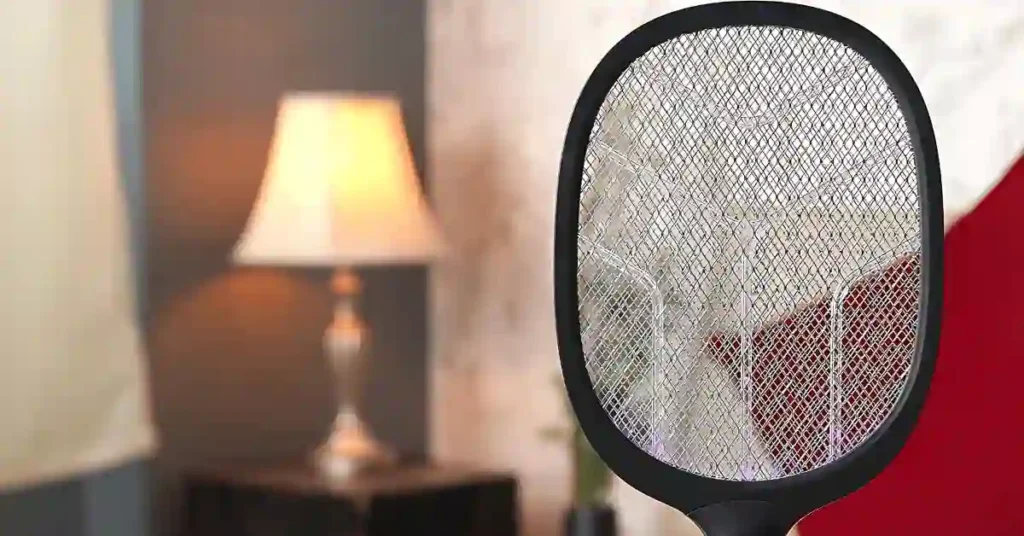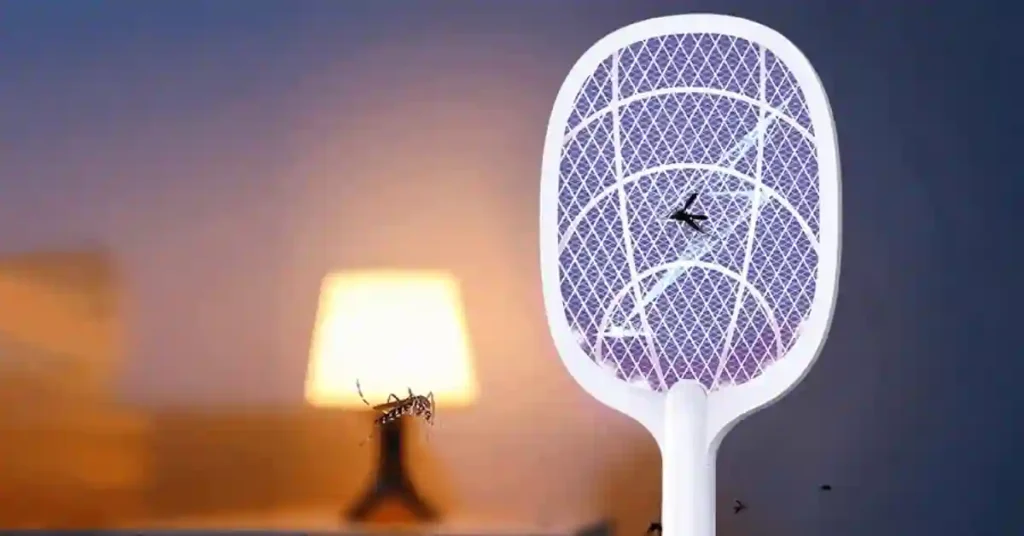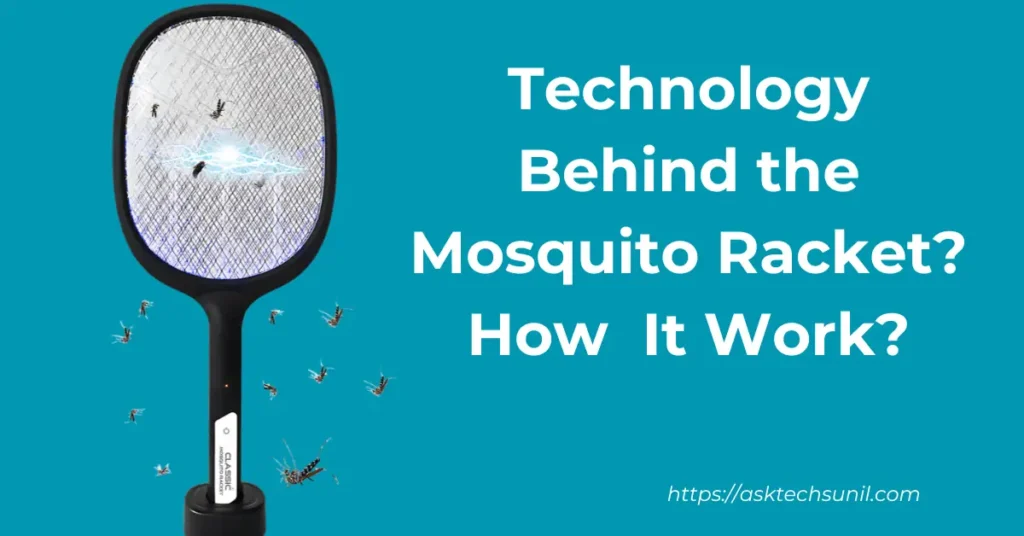Mosquitoes are notorious pests that can disrupt outdoor activities and cause diseases.
While there are numerous methods to control or repel mosquitoes, the mosquito bat is one effective tool commonly used.
This handheld device has gained popularity due to its convenience and efficiency. But have you ever wondered how mosquito bats work?
This blog post will explore the science behind these effective mosquito eliminators.
How Do Mosquito Bats Work?
Mosquito bats are handy devices we use to get rid of mosquitoes. But have you ever wondered how they work? Let’s find out!
The Design

Mosquito bats are usually designed as lightweight, handheld rackets. The frame is made of plastic, while the handle contains a battery compartment that powers the device. The head of the bat consists of a mesh grid, typically made of wire or metal, to which an electric charge is applied.
The Electric Shock
When the user presses the button on the handle, an electric current flows through the mesh grid. The grid is designed so that the wires or metal create gaps small enough for mosquitoes to pass through but large enough to contact the grid.
When a mosquito comes into contact with the grid, it completes the circuit by bridging the gap between two wires or pieces of metal, creating a path of least resistance. This allows the electric current to pass through the mosquito, resulting in an electric shock.

The Effect
When a mosquito receives an electric shock, several physiological changes occur. The high-voltage shock interferes with the insect’s nervous system, causing immediate paralysis and disrupting its ability to fly.
Furthermore, the electric shock causes rapid heating within the mosquito’s body, leading to an elevation in temperature. This sudden temperature rise can cause damage to the insect’s internal organs, eventually resulting in its death.
Advantages and Limitations
Mosquito bats offer several advantages over other mosquito control methods. Firstly, they efficiently eliminate mosquitoes, as a single swipe can kill them instantly.
They are also portable and easy to use, making them a convenient weapon against these annoying pests. Additionally, mosquito bats are environmentally friendly as they do not use chemicals or harmful substances.
However, it’s important to note that mosquito bats have their limitations. They require the user to be near the mosquitoes, making them more suitable for indoor use or when mosquitoes are within reach.
Additionally, mosquito bats may not be effective against all species of mosquitoes as some are known to be more resilient to electric shocks.
Technology Behind Mosquito Rackets

The technology within mosquito rackets can be categorized into three main components: the power source, the electrical circuit, and the mesh grid.
Power Source: Mosquito rackets are typically powered by batteries, with standard options being AA, AAA, or rechargeable batteries.
Some advanced models feature lithium-ion batteries known for their higher power output and longer lifespan. The choice of battery impacts the overall performance and longevity of the racket.
Electrical Circuit: The electrical circuit within a mosquito racket converts the low voltage from the battery into a high-voltage charge necessary for the electric current.
This circuit typically includes a transformer to boost the voltage, a capacitor to store the charge, and a switch to control the flow of electricity.
This circuit’s efficiency directly influences the racket’s effectiveness in zapping mosquitoes.
Mesh Grid: The mesh grid is the critical element where the action happens. It is where the electric current flows and where mosquitoes meet their demise.
Constructed from metal or sturdy plastic, the grid allows the current to pass through when a mosquito makes contact. The layout and spacing of the grid play a significant role in ensuring that mosquitoes are effectively zapped upon contact.
Understanding the technology behind mosquito rackets provides insight into their functionality and effectiveness in controlling mosquito populations.
Types of Mosquito Rackets (Bat)
Mosquito rackets come in various types, each offering unique features and benefits tailored to different preferences and needs.
Traditional Mosquito Racket: The traditional mosquito racket is a straightforward design featuring a handle, a battery compartment, and a metal grid. The grid is typically designed with a zig-zag pattern to increase mosquitoes’ chances of contact with it.
Rechargeable Mosquito Racket: Like traditional models, rechargeable mosquito rackets come with rechargeable batteries, offering a more eco-friendly and cost-effective solution than disposable battery-operated rackets.
UV Light Mosquito Racket: UV light mosquito rackets utilize ultraviolet light to attract mosquitoes towards the mesh grid. When mosquitoes are drawn in by the light and touch the grid, they receive a lethal shock.
Electronic Mosquito Racket: These rackets are equipped with sensors that detect the presence of mosquitoes. The electric current is activated only when mosquitoes are detected, making these rackets more energy-efficient.
Solar Mosquito Racket: Solar-powered mosquito rackets harness the power of sunlight to charge their batteries. Equipped with a small solar panel, these rackets are ideal for outdoor use and offer a sustainable, eco-friendly solution for mosquito control.
Exploring the different types of mosquito rackets allows individuals to choose the most suitable option based on their specific requirements and preferences.
How to choose the Best Mosquito Rocket
When choosing a mosquito racket, several key factors must be considered to ensure you get the best option that suits your needs.
Let’s delve into these considerations and explore some of the top choices available on the market.
Effectiveness
The effectiveness of a mosquito racket is crucial in ensuring it efficiently eliminates mosquitoes.
Factors like voltage, mesh size, and overall design significantly determine how well the racket can zap mosquitoes.
Rackets with higher voltage are generally more effective at killing mosquitoes but may consume more battery life.
Additionally, a larger mesh size allows you to catch more mosquitoes simultaneously, although it may make the racket heavier and less manoeuvrable.
Battery Life
Battery life is essential, especially if you intend to use the mosquito racket for extended periods.
Electric and rechargeable mosquito rackets typically offer a battery life of around 4-6 hours, providing sufficient usage time.
On the other hand, solar mosquito rackets can last up to 8 hours on a full charge, offering more extended operational periods without frequent recharging.
Selecting a racket with an adequate battery life ensures uninterrupted mosquito control when needed.
Design
The design of a mosquito racket is another critical factor to think about.
Some rackets feature ergonomic designs that make them comfortable to handle and use, reducing strain during prolonged use.
Additionally, the appearance of the racket can vary, with some models offering a more stylish look.
Choosing a design that you find comfortable and visually appealing enhances the overall user experience and ensures you are satisfied with your choice.
Top Mosquito Rockets on the Market
1. Gaiatop Anti-Mosquito Racquet: This racket features a shock-proof ABS build, USB charging, a large net area, and a 6-month warranty.
It is easy to use and offers reliable mosquito-zapping capabilities.
2. Yage by Rozzby Mosquito Killer Racket: Known for its shock-proof design, USB charging, large net area, and 6-month warranty, this racket is user-friendly and effective in eliminating mosquitoes.
3. GaxQuly 2-in-1 Mosquito Bat: With a UV lamp feature to attract and kill mosquitoes, a shock-proof design, overcharge protection, and high durability ratings, this racket offers a comprehensive solution for mosquito control.
4. Hit Anti-mosquito Racquet: Featuring an easy-to-grip handle, a 6-month warranty, easy usability, a two-pin charge mechanism, and excellent value for money, this racket is a practical choice for mosquito elimination.
5. Giga Watts Rechargeable Mosquito Killer Racket:
This racket boasts a durable plastic build, an inbuilt lamp for locating mosquitoes in the dark, easy cleaning after use, and a simple one-button operation for quick and effective mosquito control.
By considering factors like effectiveness, battery life, and design, along with exploring top options like the ones mentioned above, you can make an informed decision when choosing a mosquito racket that best suits your preferences and requirements.
Conclusion: Enjoying the Outdoors Mosquito-Free
Mosquitoes can be a real pain, but with mosquito rackets, you can fight back and enjoy your time outdoors without worrying about those buzzing bugs.
By understanding how these devices work and choosing the right one, you can keep your space mosquito-free and have a more pleasant time outside.
So, grab your trusty mosquito racket and zap those bugs away the next time you hear that annoying mosquito buzz!
FAQs:- Technology Behind the Mosquito Racket?
Q1. How Does Mosquito Mosquito Racket Work?
The mosquito racket operates through the activation of an electrically charged mesh. This mesh, typically carrying a voltage ranging from 2,000 to 4,000 volts, is a lethal trap for mosquitoes and other flying insects. When a mosquito touches the electrified mesh, it closes the circuit, leading to the insect receiving a powerful shock that results in its immediate demise. This mechanism effectively eliminates mosquitoes without posing a significant risk of harm to humans, as the voltage is calibrated to be lethal to insects but safe for human contact. The design of the racket, resembling a tennis racket, allows users to swing and target mosquitoes easily. The visible “bug fireworks” effect produced when an insect is zapped confirms the racket’s effectiveness. Overall, the mosquito racket provides a convenient and efficient solution for controlling mosquito populations and reducing insect nuisance outdoors.
Q2. Are mosquito rackets effective?
Mosquito rackets are suitable for swatting and killing mosquitoes you see directly. They’re zap-and-go swatters but won’t keep mosquitoes away from you or eliminate a large infestation. Consider them a targeted tool for immediate mosquito problems.
Q3. Is a mosquito racket safe to use around children and pets?
Mosquito rackets can be safe around children and pets with caution, but supervision is vital. The outer mesh is usually harmless, and the shock only happens with contact on both meshes.
However, to minimize risks:
Keep the racket out of reach when not in use.
Adult supervision is a must when using it.
Look for rackets with safety features like deactivation switches.
Q4. Do mosquito rackets work on other insects?
Yes, mosquito rackets work on other insects besides mosquitoes! They zap any flying insect that makes contact with both the outer grounded mesh and the inner electrified mesh, completing the electric circuit. This includes flies, moths, gnats, and even wasps (though be cautious with wasps!). The size of the insect might affect things slightly – a very tiny fly might avoid the zap if it doesn’t touch both meshes. But for most flying insects, the mosquito racket delivers a shocking surprise.


